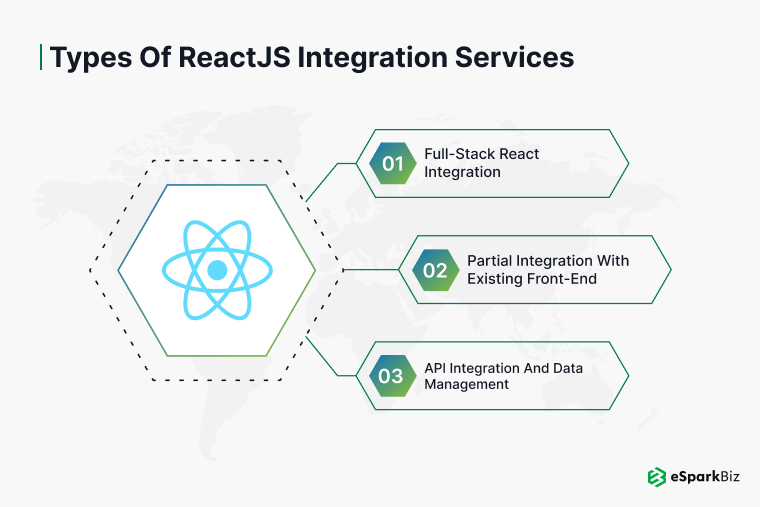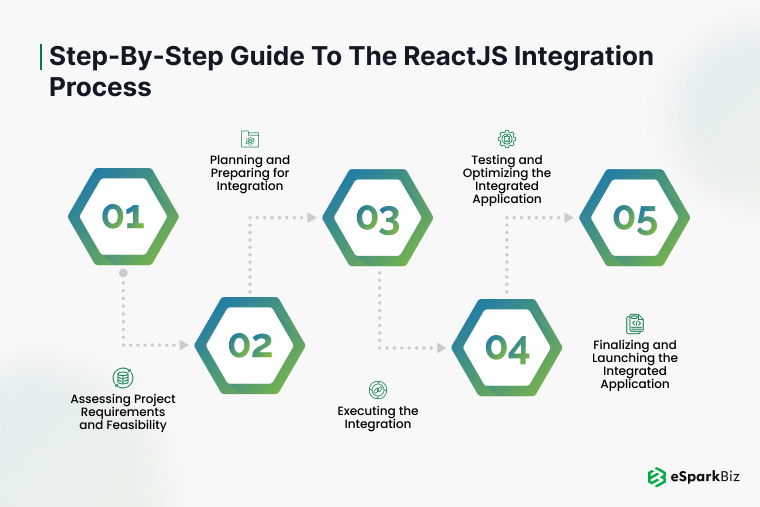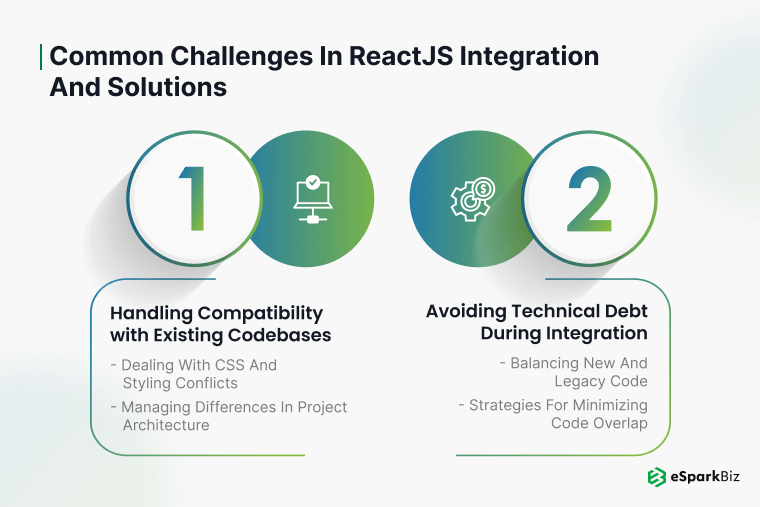More and more businesses and professional developers are looking for UI optimization and app optimization. Probably the most effective is ReactJS, a JavaScript library that can be used to develop interactive and dynamic web apps. ReactJS Development Services is a perfect fit for those projects where the overall user experience is needed, and you want to control the state of the application.
ReactJS can be a little difficult to integrate into a working project, especially for legacy ReactJS application development services or legacy code that is created in a classic way. But the payoffs are worth it. ReactJS integration services make it easy to add it in, thereby making your front-end work more efficient and easier to maintain.
Why React JS is Ideal for Integration?
ReactJS is great for seamless enterprise application integration because of the component-based model, so you can make UI reusable components. Because of React’s flexibility with regard to complex state management and dynamic rendering, it is one of the preferred options for upgrading legacy systems. You can implement React gradually or fully, as needed for the project, irrespective of whether you are developing a small application or an enterprise system.
Understanding ReactJS Integration Services
What is ReactJS Integration?
ReactJS integration is when you add React to an existing application or project. Whether it is a complete move with a rewrite of the entire front-end development using React or partial, slow integration (no more features/ components are implemented in React while the rest of the project remains unchanged), the purpose is to utilize React benefits within the current system.
Core Aspects of ReactJS Integration
The core aspects of ReactJS integration include:-
Component-based architecture: React builds UI components that can be reused, which reduces the integration time and cost.
Virtual DOM: With React’s virtual DOM, updating the actual DOM is relatively slow by making sure that little change is made to the actual DOM, and the result is a faster render.
Learn how Virtual DOM enhances web performance by minimizing real DOM changes and efficiently rendering updates. #DEVCommunity #ReactJShttps://t.co/QEanO7D9F3
— The React Dev (@The_React_Dev) November 5, 2024
State management: There are a lot of tools for maintaining the state in React such as React Context API, Redux, or external libraries.
Benefits of Integrating React JS into Existing Projects
There are several benefits to integrating React into your project:-
Enhance User Experience: With React, you get more responsive, dynamic user interfaces, faster responses, and real-time notifications.
Improve Performance: Virtual DOM and optimizations such as code splitting make the system performance better even for massive applications.
Maintainability: Applications built using ReactJS components are more scalable.
Faster Development: With the help of reusable components, ReactJS developers can achieve increased development speeds.
Key Scenarios for Using ReactJS Integration Services
You can apply React JS to any web projects, whether it’s a legacy application, enterprise app, or mobile app. Below are some common scenarios where ReactJS integration services are particularly useful.
Adding Interactivity to Legacy Applications
For old-fashioned applications, (built with old-school JavaScript or non-interactive technologies) React provides interactivity to their application. For instance, instead of completely rewriting an older app, you can use React to plug into core pieces like forms or dashboards to improve the User interface leveraging the React UI frameworks.
Enhancing Existing Front-End Frameworks with React
If you’re working with a project that relies on other front-end libraries, such as AngularJS or Vue.js, React can be used to power certain functions. The declarative UI and component-oriented nature of React can help to round out the other front-end frameworks and bring seamless transitions.
Types of ReactJS Integration Services

There are different methods to use the ReactJS library in your project, based on your project scope and business objectives. Let’s see the most popular types of ReactJS integration services.
Full-Stack React Integration
In React, you can integrate it on the front-end and back-end of the project. This often means that you need to combine React with some backend technology like Node.js, Express, or a similar server-side system.
Integrating React with Backend Technologies
If you use React completely, the back-end services may also need to be refactored to work with React’s architecture. A standard back-end integration would be REST APIs, graphQL or databases like MongoDB or SQL. React loads these back-end services data to render the dynamic content.
Key Considerations for Full-Stack Integration
Seamless Data flow: React must interact with the back-end services, so data flow must be carefully managed.
Authentication: Integrating React with security protocols is crucial if the application requires user authentication.
State management: When working with full-stack development solutions, state management (such as Redux) will be key in syncing front-end and back-end data.
Partial Integration with Existing Front-End
React can be implemented only for certain sections of a project, while the rest of the front end remains intact.
Integrating React JS into Non-React Front-End Projects
Where the front end already has non-React frameworks or vanilla JavaScript, you can deploy React on some of the components or pages. This allows to migrate portions of the project without breaking the entire application.
Strategies for Gradual Integration
Component Replacement: Identify components (e.g., forms, data tables) you could replace with ReactJS components.
Progressive Enhancement: React can be applied to individual pages or functions to extend them without affecting the entire project.
ReactJS API Integration and Data Management
React JS likes to run on data-driven applications, and it is the most impressive feature of React to integrate APIs.
Using React with REST APIs and GraphQL
For retrieving and presenting dynamic content, React is very easily integrated with REST APIs and GraphQL. Data is supplied by APIs, and React consumes it to render components.
Managing Data with React State and Context API
ReactJS Developers can store and share data between components with React’s state management. For bigger React projects, you can use the Context API or state management library like Redux with React to manage the data globally.
Tabular Representation for Key ReactJS Integration Types and Benefits
| Integration Type | Description | Best For | Benefits |
| Full-Stack Integration | Adds React to a back-end library like, say, Node.js or Django | Deliver Projects that require an end-to-end development process | Cohesive front and back-end interaction |
| Partial Integration | Integrates ReactJS components to specific UI parts | Enhancing particular areas without ultimately building from scratch | Reduced disruption, faster deployment |
| Micro-Frontend Approach | Utilizes React for modular front-end architecture | Large applications with independent modules | Flexible scaling, reduced interdependencies |
Step-by-Step Guide To The ReactJS Integration Process

Step 1: Assessing Project Requirements and Feasibility
Before diving in, look at what you have now and where React can make a difference. Describe what you want to integrate and the components that will be integrated.
Step 2: Planning and Preparing for Integration
Planning is critical. Choose an integration approach (full stack or partial) and be ready for compatibility needs. This avoids disruption and makes the integration on project timescales.
Step 3: Executing the Integration
Now that you have the roadmap, set up your environment and start deploying React to those areas. Combine it with any API or database you already have to allow the data to flow between ReactJS components and other parts of the application.
Step 4: Testing and Optimizing the Integrated Application
After it’s installed, run all-encompassing tests to make sure that it’s compliant, fast, and consistent with the UI. Correct any issues for a clean user interface.
Step 5: Finalizing and Launching the Integrated Application
After testing, conduct quality checks and get set for a good launch. Check the new merged app is functioning and optimized.
Best Practices to Enable ReactJS Integration with a High Success Rate
Maintain Code Consistency and Modularity
It is a very important task to design React integration with a modular and clean code base. That’s easier to debug, test and update later on in the code, without messing up the project.
Focus on Performance Optimization
React provides lots of code splitting and lazy loading features which can speed up by minimizing initial loading time. Also memorizing saves time by re-running redundant stuff that speeds up the app.
Also Read: React Best Practices – Step towards Boosting Development Performance
Ensuring Smooth Team Collaboration
Integration work is teamwork. Git and communications such as Slack can keep everybody on the same page.
ReactJS Integration with Popular Technologies
Integration with Node.js and Express
Using React with Node and Express Stacking is a really strong approach. It is a fantastic configuration for applications that require real-time data and a scalable back-end.
Integration with Python/Django Back-End
Django and React make super scalable and performant web apps if you already work with Python projects. Thanks to Django REST, React fetches data and talks to the backend.
Integration with Legacy Systems
ReactJS Web App Development approach is not so good with legacy systems but can be planned for. These can be API layering and gradual component replacement which retains your functionality but updates the UI.
Also Read: Proven Technology Combinations for Building High-Performance ReactJS Applications
Technical Aspects of ReactJS Integration
To make ReactJS integration run seamlessly, you must know the technical details of the integration.
Controlling State and Data Flow in Packages Projects
The state management feature in React is necessary for component-based data updates.
State & Context API and Redux
Context API and Redux are two popular state managers in React. They help in enhancing ReactJS developer skills in controlling the state of components globally, which helps with the data passing through.
Transferring Data Between React and Non-React Blocks
Data can be difficult to flow between frameworks if you collaborate with React with legacy or non-React components. Props, state, or even a common event bus are needed to connect.
Ensuring Performance Optimization During Integration
Keeping the performance going is key to any project. Here are some of the essential ReactJS Performance Optimization techniques to enhance development speed and result quality:-
Lazy Loading and Code Splitting
Lazy loading and code splitting in React make sure only needed code gets loaded first to decrease page times.
Avoiding Needless Re-Renders Through Memorization
Memorization methods such as React.memo() will save you a lot of re-renders by keeping the memory low and putting less strain on the browser.
Testing and Debugging Integrated React Applications
Thorough testing and debugging are critical in any integration project.
Testing Tools for Integrated Projects (Jest, Enzyme)
Jest and Enzyme are popular testing tools for the React app, helping ensure that components are working as expected.
Setting Up Effective Debugging Practices
Use tools like React Developer Tools to debug issues and optimize the performance of the integrated application.
Common Challenges in ReactJS Integration and Solutions

While integrating React can be highly beneficial, experienced developers may face some software development challenges.
Handling Compatibility with Existing Codebases
Dealing with CSS and Styling Conflicts
CSS conflicts can arise when integrating React into an existing project, especially when using different styling frameworks. One of the intuitive reactjs solutions is to use CSS-in-JS libraries like styled components to manage styles in React.
Managing Differences in Project Architecture
Hire ReactJS Developers with core experience can help you to ensure the existing architecture can accommodate React’s component-based structure. Refactor the project if necessary to create a clean separation of concerns.
Avoiding Technical Debt During Integration
Balancing New and Legacy Code
Striking a balance between React and legacy code can result in technical debt if not managed carefully. Plan for gradual migrations and ensure that legacy code remains maintainable.
Strategies for Minimizing Code Overlap
Minimize code overlap by creating clear boundaries between React and non-React components. Use version control to manage changes.
Also Read: How Software Developers Ensure Code Quality?
Choosing a ReactJS Integration Service Provider
When selecting a ReactJS integration partner, look for providers with the following qualities:
Key Qualities to Look for in a ReactJS Integration Partner
Expertise in JavaScript and React JS: The provider should have deep knowledge of React JS and its ecosystem.
Experience with Similar Integrations: Prior experience with integrating React into similar projects is crucial.
What Are The Advantages Of ReactJS Integration Services For Your Business Goals?
ReactJS integration services give businesses a quicker time-to-market, better UI, and long-term projects scale so you don’t fall behind the competition.
Integrated Development and reduce Time-to-Market: Enable React to sync with Node to quickly create, deploy, and scale apps in minutes, decreasing development process time and TTM.
UX & New React Functions For UX Optimization: Enhance the dynamism, responsiveness, and readability of interfaces for your enterprise applications with React and leveraging its brand-new sophisticated functions like hooks, context API, and virtual DOM to provide a better UX experience with new React functions.
Conclusion
React JS is very useful to create UI and modify current web applications. Whether you’re extending an existing legacy system or upgrading your front-end code, Custom ReactJS Development delivers the flexibility, performance, and scalability you need to power the modern ReactJS web development services. Even though user needs keep changing, so it is crucial to cope up with the evolving ReactJS Trends, using React JS in your code will benefit in the long run with performance, user engagement, and maintainability.
Why choose eSparkBiz For ReactJS Integration Services?
eSparkBiz is a Leading ReactJS Development Company possessing impressive expertise and history for ReactJS integration, so you’ll be able to integrate it easily with your existing systems. We know what it takes to implement legacy systems, partial integrations, and full-stack changes so we can tailor our strategy to fit your business needs. Here is why eSparkBiz is an incredibly excellent ReactJS Integration Partner for you:
Well-Delivered Development Team: Skilled React Developers who know all about front-end and back-end integration.
Tailored Integration Plans: Tailored integration plans for your existing infrastructure and business needs.
Easy ReactJS Migration: Very little interruption during the integration, so you can enjoy the same performance and user experience.
Performance: Benefit from React’s code splitting and lazy loading capabilities to make your app fast and effective.
Maintenance: From design to launch, monitoring, and maintenance services.
Ready to integrate ReactJS capabilities in your project? Consult with eSparkBiz now and let’s get started on integrating ReactJS to have a clean, performant front-end together!
-
What is the main advantage of ReactJS integration for legacy applications?
Advantages of using React is it seamlessly makes legacy apps modern, interactive, and easy to migrate without a complete rewrite.
-
How does ReactJS integration impact existing code performance?
React increases performance by supporting the virtual DOM, eliminating bloated rendering and lazy loading, code splitting, etc.
-
Is React integration suitable for small-scale applications?
React is suitable for small-scale projects, and its advantages are that it is faster and more user-friendly.
-
Can you integrate React into a non-React application?
Yes, React can be gradually introduced into non-React applications – so it can be integrated part-way without undue complication.
-
What are the common challenges of integrating React JS into existing projects?
Common problems include integrating with legacy code, styling conflicts, and integrating new and old code without technical debt.







